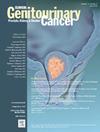Diagnostic Accuracy of Contrast-Enhanced Ultrasound in Differentiating RCC from AML in Small Hyperechoic Renal Masses (≤ 3 cm): A Retrospective Single-Center Study
IF 2.7
3区 医学
Q3 ONCOLOGY
引用次数: 0
Abstract
Background
Small (≤ 3 cm) hyperechoic renal masses are challenging to characterize due to overlapping features between angiomyolipomas (AMLs) and renal cell carcinomas (RCCs). Contrast-enhanced ultrasound (CEUS) offers a noninvasive alternative, particularly when CT or MRI are inconclusive or contraindicated. This study assessed CEUS diagnostic accuracy in differentiating RCC from AML and identified predictive enhancement patterns.
Methods
In this retrospective single-center study, 104 patients with incidentally detected small hyperechoic renal masses underwent CEUS between December 2021 and July 2024. Two blinded radiologists independently assessed wash-in and wash-out dynamics, peak intensity, homogeneity, and perilesional rim-like enhancement. Histopathology was obtained when available; lesions with ≥ 18 months of stable imaging follow-up were considered benign. Diagnostic metrics, interobserver agreement (ICC), and multivariate logistic regression (IBM SPSS Statistics 29.0) were used to identify independent predictors, reported as odds ratios (ORs) with 95% confidence intervals (CIs).
Results
Of 104 lesions, 80 were classified as AMLs and followed with ultrasound, while 28 were biopsied, confirming 26 RCCs (papillary 53%, chromophobe 32%, clear cell 15%) and 2 atypical AMLs. Rapid wash-out (sensitivity = 84%, specificity = 91%, AUC = 0.90) and perilesional rim-like enhancement (specificity = 95%, PPV = 90%) were the strongest CEUS predictors of RCC. Multivariate analysis identified rapid wash-out (OR = 5.0; 95% CI, 2.0-12.0) and perilesional enhancement (OR = 3.8; 95% CI, 1.5-10.0) as independent predictors. Combined CEUS features achieved an AUC = 0.93. Interobserver agreement was good (ICC 0.75–0.9).
Conclusion
CEUS accurately differentiates RCC from AML in small hyperechoic renal masses. Rapid wash-out and perilesional rim-like enhancement are independent predictors of malignancy and may guide biopsy versus surveillance decisions.
对比增强超声鉴别肾小高回声肿块(≤3cm)与急性髓性白血病的诊断准确性:一项回顾性单中心研究
由于血管平滑肌脂肪瘤(AMLs)和肾细胞癌(rcc)之间的重叠特征,小的(≤3cm)高回声肾肿块的特征很难确定。对比增强超声(CEUS)提供了一种无创的替代方法,特别是当CT或MRI不确定或有禁忌时。本研究评估了超声造影在鉴别肾细胞癌和急性髓性白血病中的诊断准确性,并确定了预测性增强模式。方法在本回顾性单中心研究中,在2021年12月至2024年7月期间,104例偶然发现小高回声肾肿块的患者接受了超声造影。两名盲法放射科医师独立评估洗入和洗出动态、峰值强度、均匀性和病灶周围边缘样增强。可用时进行组织病理学检查;影像学稳定随访≥18个月的病变被认为是良性的。使用诊断指标、观察者间一致性(ICC)和多变量逻辑回归(IBM SPSS Statistics 29.0)来确定独立预测因子,报告为95%置信区间(ci)的比值比(ORs)。结果104例病变中,80例为aml并行超声检查,28例活检,证实rcc 26例(乳头状53%,厌色32%,透明细胞15%),2例为不典型aml。快速冲洗(敏感性= 84%,特异性= 91%,AUC = 0.90)和病灶周围边缘样增强(特异性= 95%,PPV = 90%)是超声造影预测RCC的最强指标。多变量分析确定快速洗脱(OR = 5.0; 95% CI, 2.0-12.0)和病灶周围增强(OR = 3.8; 95% CI, 1.5-10.0)为独立预测因子。综合超声造影特征AUC = 0.93。观察员间一致意见良好(ICC 0.75-0.9)。结论超声造影能准确鉴别肾小高回声肿块的肾小细胞癌和急性髓性白血病。快速冲洗和病灶周围边缘样增强是恶性肿瘤的独立预测因子,可以指导活检与监测的决定。
本文章由计算机程序翻译,如有差异,请以英文原文为准。
求助全文
约1分钟内获得全文
求助全文
来源期刊

Clinical genitourinary cancer
医学-泌尿学与肾脏学
CiteScore
5.20
自引率
6.20%
发文量
201
审稿时长
54 days
期刊介绍:
Clinical Genitourinary Cancer is a peer-reviewed journal that publishes original articles describing various aspects of clinical and translational research in genitourinary cancers. Clinical Genitourinary Cancer is devoted to articles on detection, diagnosis, prevention, and treatment of genitourinary cancers. The main emphasis is on recent scientific developments in all areas related to genitourinary malignancies. Specific areas of interest include clinical research and mechanistic approaches; drug sensitivity and resistance; gene and antisense therapy; pathology, markers, and prognostic indicators; chemoprevention strategies; multimodality therapy; and integration of various approaches.
 求助内容:
求助内容: 应助结果提醒方式:
应助结果提醒方式:


